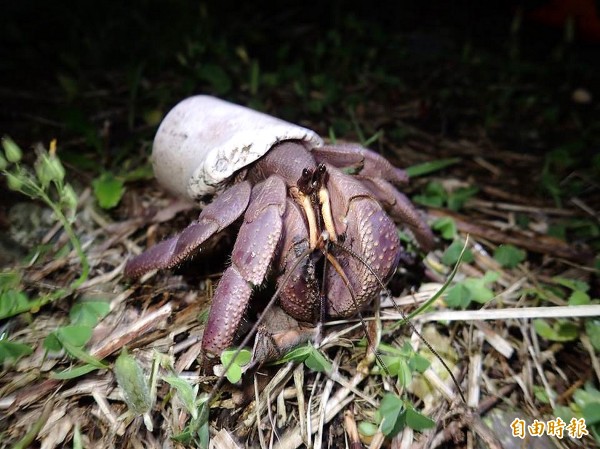《TAIPEI TIMES》 Taitung hermit crabs using plastic bottle caps as shells

A hermit crab using a plastic bottle cap as a shell is seen in an undated photograph provided by National Cheng Kung University Center for Research in Water Science and Technology researcher Chiu Yu-wen. Photo courtesy of Chiu Yu-wen
By Tsai Wen-chu and Sherry Hsiao / Staff reporter, with staff writer
Most of the Coenobita brevimanus, a species of land hermit crabs, in the Sansiantai area (三仙台) in Taitung County’s Chenggong Township (成功) are using plastic bottle caps as shells, a Tainan-based marine biologist said on Sunday.
Chiu Yu-wen (邱郁文), a researcher at National Cheng Kung University’s Center for Research in Water Science and Technology, said he last week traveled to the area to conduct research on hermit crabs and discovered that among the 14 Coenobita brevimanus that he encountered, most of them were using plastic bottle caps as shells.
Even the few crabs that had shells were carrying ones that were either damaged or too small to fully protect their bodies, he said.
The carapace of the Coenobita brevimanus can measure up to 45mm, Chiu said, adding that they are the second-largest species of hermit crabs in Taiwan.
Unlike natural shells, plastic bottle caps and damaged shells do not provide hermit crabs with an effective and confined shelter for defense, Chiu said.
Apart from being unable to effectively defend themselves against predators, hermit crabs that use plastic bottle caps as shells or damaged shells are also unable to prevent water from evaporating from their bodies, let alone reproduce during the breeding season, he said.
Hermit crabs are also unable to steadily hook onto plastic bottle caps using their abdominal appendages due to the smooth liner inside the caps, he added.
Chiu said that part of the problem is that when edible shellfish are consumed at restaurants, empty shells are not returned to the shores, thereby creating an insufficient supply of shells for hermit crabs.
Hermit crabs on other shores face similar problems, he added.
Due to their proximity to farms and windbreaks, Tainan’s hermit crabs can substitute the shells of shellfish with the shells of the Lissachatina fulica, a species of land snail also known as the giant African snail, Chiu said.
However, because the shells of snails are thin and fragile, they are not ideal, he said.
A short-term solution would be to set up a collection point for shells near the entrance to the Sansiantai area, he said.
However, to maintain the hermit crabs’ habitat — including the environment and the quality of water — and ensure a sustainable management of fishery resources, long-term investment is needed, Chiu said, adding that right now, the most urgent task is to find shells for the crabs.
新聞來源:TAIPEI TIMES



















